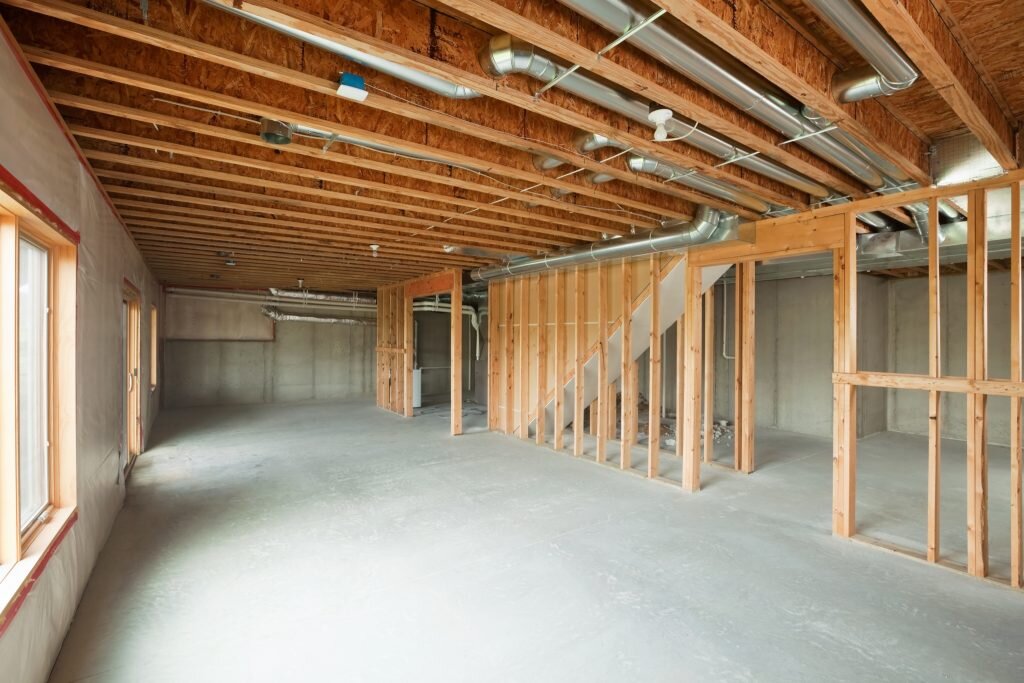
Many sellers, and even homeowners who are just thinking about selling in the next few years, wonder if going through the time and expense of finishing a basement is a value-add improvement. Generally the answer is yes, but that doesn’t mean that a finished basement is always the best way to invest your home improvement dollars.
In terms of home value, finished basements aren’t as valuable as main-floor living space and above-grade bedrooms (“above-grade” refers to a room that’s located higher than ground level — that could mean on a main floor or upstairs, just not in a basement). A main-floor addition will likely be more valuable than a finished basement, but the expense could be much higher.
Should I finish my basement?
Whether you should finish your basement depends on your lifestyle, your local real estate market and your goals in finishing the space. For example, let’s say you’re a movie buff and don’t plan on selling for another few years. Building a home theater in your basement might well be worth it. You’ll see an average 70 percent return on investment, and the 30 percent you don’t make up might feel worth it when you consider the years you’ll be able to enjoy the basement theater before selling.
Types of finished basements
There are three primary types of finished basements. Which type of basement renovation you choose varies based on your home’s existing structure and how much money you are willing to spend.
Walk-out basement
Generally the most attractive to buyers because of the amount of natural light, a walk-out basement has a full-size door (often a slider) that leads to outdoor space, like a backyard or patio. This type of basement is more like a ground floor (due to a property with at least 6 feet of slope from front to back), which also allows for bigger windows and more natural light — something buyers love.
In a home with a walk-out basement, the main floor will be at street level in the front of the home but elevated from the back, often with a porch or deck. Note that in some markets, the MLS will count walk-out basements as above-grade when it comes to calculating the price per square foot (more on that later).
Standard lot basement
This is what you may think of when you picture a traditional basement. A standard lot basement is underground, with concrete basement walls and no natural light other than small window wells near the ceiling. A standard lot basement usually pushes the main level a few feet above ground, so there might be a couple of steps to get down from the main floor into the backyard. Given the lack of natural light, a standard lot basement is less attractive to buyers at resale.
Garden-level lot basement
A middle ground between a standard lot basement and a walk-out basement, a garden-level lot basement is partially above ground and partially below ground, due to a somewhat sloping lot. A garden-level lot basement may have a combination of full-size windows and small window wells, but it’s not likely to have a door to the backyard.
Finished basement return on investment
As with any big renovation, it’s important to note that when finishing a basement, you may not recoup all of your investment. It’s usually advised to finish a basement for your own enjoyment, then recoup some of the money spent down the road when you decide it’s time to sell.
That said, there are buyers that actively seek homes with finished basements. And in a competitive buyers market, your home can really stand out among other for-sale homes if it is one of only a few with a finished, functional basement.
Basement remodel cost and ROI by region
According to Remodeling magazine’s Cost vs. Value Report 2017, a midrange basement remodel (meaning the materials used are not builder-grade or basic, yet not luxury) costs an average or $71,115 nationally and recoups $49,768 (or roughly 70 percent) at resale, a slight decrease from the previous year.
- Homeowners in the Pacific region, which includes California, Hawaii, Washington, Oregon and Alaska, are likely to see the biggest ROI on a basement remodel at 86.4 percent. In this region, the average basement remodel cost is $84,062, and the resale return is $72,664.
- Homeowners in the West South Central region of the United States, including Oklahoma, Arkansas, Texas and Louisiana, see the second-highest return at 80.8 percent, with an average remodel cost of $64,827 and an average resale return of $52,368.
- Homeowners in New England (Maine, New Hampshire, Vermont, Massachusetts, Rhode Island and Connecticut) are likely to see the lowest return at 52.8 percent. Basement remodel costs average out at $76,429 in this region, but the resale return is only $40,377. Homeowners in Wisconsin, Illinois, Indiana, Michigan and Ohio aren’t far behind, with an average ROI of just 53.3 percent.
How appraisers evaluate finished basements
If selling is on your mind, you’re probably thinking about finishing your basement for resale and marketing purposes, not for personal enjoyment. In that case, understanding how home basements are appraised will give you a better understanding of how it will impact your home’s overall value.
First, to understand how appraisers calculate value when it comes to basements, you’ll need to know three key terms:
- Above-grade: Above-grade refers to a room or living area that is not in the basement. It’s located above ground level.
- Below-grade: Below-grade refers to rooms or living areas in the basement, or below ground level.
- Gross living area: According to the Appraisal Institute, the gross living area is the total area of finished, above-grade residential space. It is measured using the perimeter of the house and only includes completed, habitable and above-grade living space, so note that your finished basement will typically not be included in this figure.
Appraisers may start with a rough gauge of the price per square foot of your house, and how much of your home is above-grade versus below-grade can make a difference. Below-grade living space is worth about half that of above-grade living space. So, if the price per square foot in your area is $150, your basement price per square foot would be $75. Appraisers may also calculate the price per square foot for the entire home, then divide it by the gross living area.
Another thing appraisers do is run comps, using similar homes in your area that have sold recently to identify the correct value of your home. When appraising a home with a basement, skilled appraisers will only compare homes that have similar amounts of above-grade living area. For example, if your home has 1,500 square feet of above-grade area and 500 square feet of basement space, an appraiser wouldn’t compare it to a home with 2,000 feet of above-grade living area. So, if you’re doing your own research on comparables, make sure to keep this in mind to avoid overpricing your home.
Tips for finishing a basement to add home value
Completing an unfinished basement isn’t as simple as just adding some drywall and flooring. You’ll also want to check local laws and permit requirements. Another consideration when planning a basement remodel is to weigh the type of layout you want to create with the potential of the available space. Professional tips like maximizing lighting and selecting moisture-proof materials can help during the planning phase as well.
1. Check the local laws
You’ll probably need a permit to finish your basement, and checking with your local jurisdiction about the cost of permits and what it takes to get your project approved should always be your first step.
Homeowners are sometimes tempted to skip the permit process, since it’s another cost, and the work isn’t easily seen from the street, so you’re less likely to be caught. But if you do get caught, you may have to pay a hefty fine. It’s important to note that reputable contractors will refuse to work without a permit, and if you want the job done right — and safely — you won’t want to use an under-the-table contractor.
Additionally, renovations without permits can be a big red flag for buyers during a home inspection or disclosure process, sometimes causing them to want to renegotiate or even walk away from the deal.
2. Choose a function
If you’re finishing a basement for your own use, you’ll want to add the rooms that make the most sense for your lifestyle — maybe you need a guest bedroom, a bigger laundry room or a playroom for your kids. But if you’re finishing a basement for resale purposes, you’ll want to consider what sells best in your market.
It’s important to remember that the style, look and quality of the finishes in your basement should match the rest of your home. For example, if you have a high-end home, you should have a high-end basement.
3. Select your layout
Generally speaking, buyers are looking for open floor plans. One challenge people face when finishing basements is working around load-bearing walls and systems like the water heater, electrical box and furnace, which are often housed there. Before you get too far into your planning, talk to your contractor about what’s feasible in your specific space.
It’s also noteworthy that according to the Zillow Group Consumer Housing Trends Report 2018, 60 percent of buyers in the last year said it was extremely important that a home included a spare or guest bedroom, so if your home doesn’t have an above-grade guest bedroom, that might be a smart addition.
4. Check your ceiling height
Standard building code calls for at least 7-foot ceilings (always check with your local city official’s office). But in a basement with limited light, the higher the ceilings, the better. Pipes and ductwork are two of the key reasons basements end up with low ceilings, so have a conversation with your contractor about what can be done to maximize ceiling height.
5. Prioritize light
If you are able to create a walk-out basement, you’ll add a lot more natural light, which will not only make the space more enjoyable for you but also make the basement more attractive to buyers.
But even if you’re only able to finish your standard lot basement, you’ll still want to focus on light. Compensate for the lack of natural light by adding as much lighting as possible. Recessed lighting can be a great way to create all-over brightness in a basement, without causing low-ceiling clearance issues.
6. Choose the right basement flooring
When finishing the basement floor, pay extra attention to flooring materials. In most cases, you won’t be able to install hardwood floors in basements because of moisture issues that can cause warping and gapping.
Good options are high-quality carpet or carpet tiles (both of which can combat the cold feeling commonly found in basements), or quality vinyl if you live in a warmer climate and keeping cozy is less of a concern.





